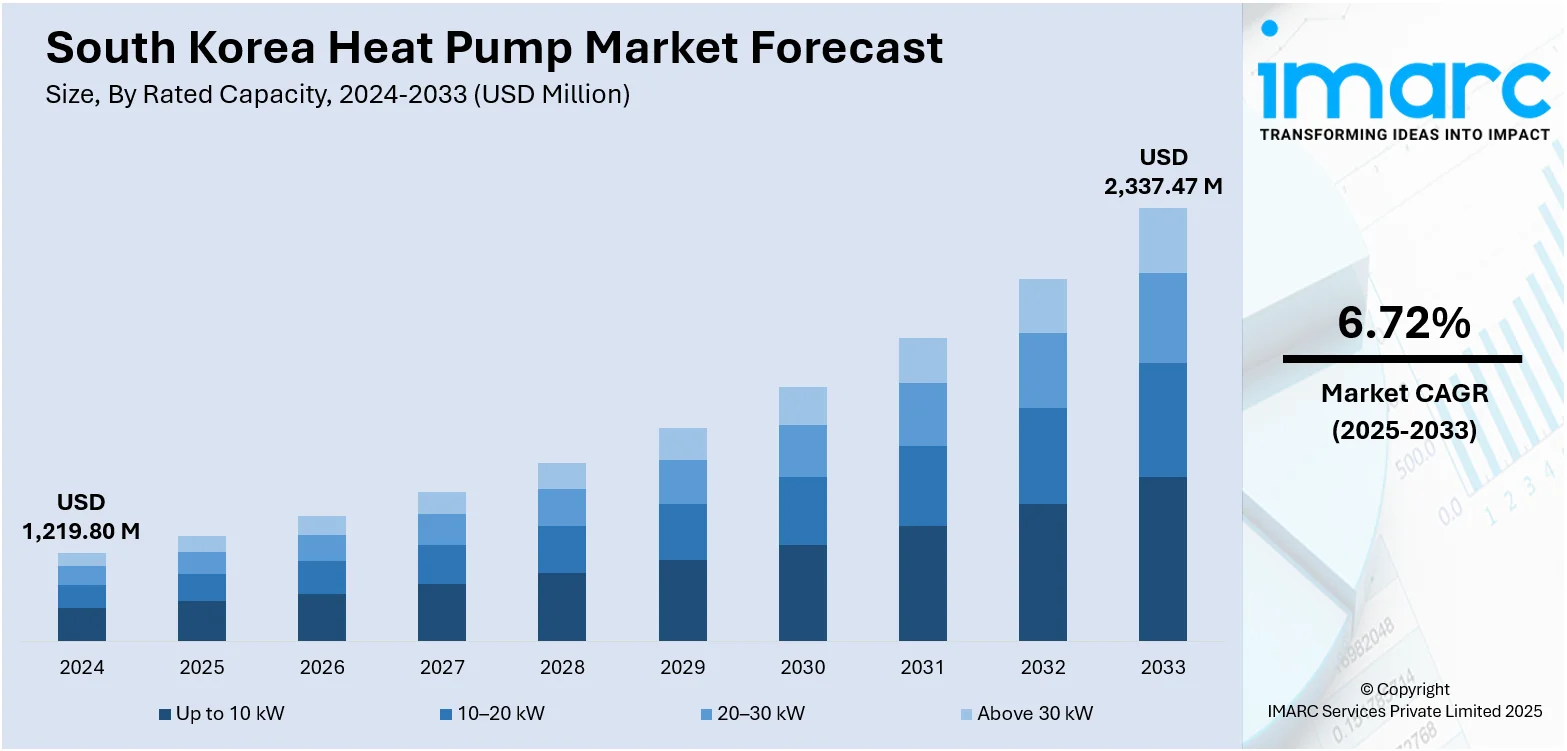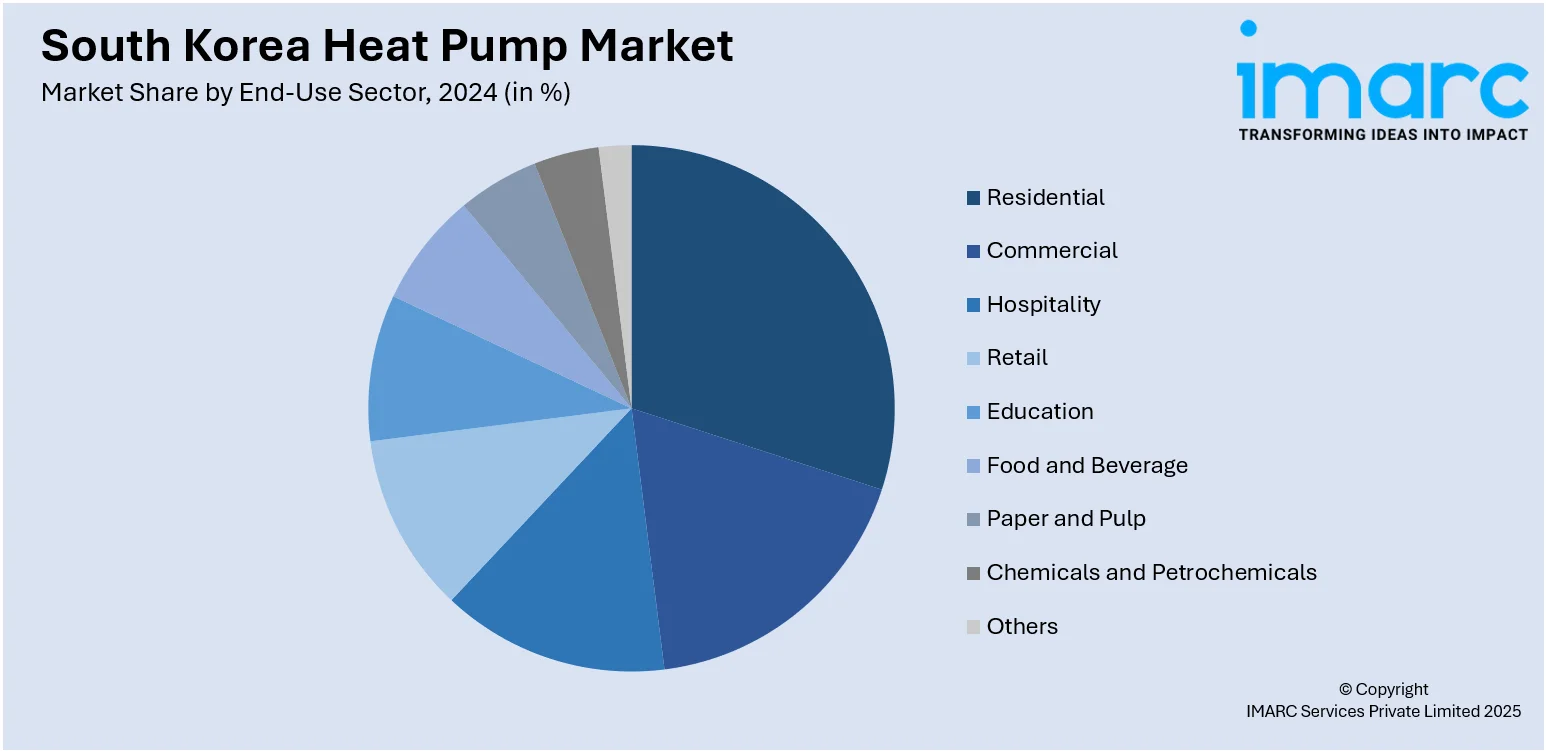
South Korea Heat Pump Market Size, Share, Trends and Forecast by Rated Capacity, Product Type, End-Use Sector, and Region, 2025-2033
South Korea Heat Pump Market Overview:
The South Korea heat pump market size reached USD 1,219.80 Million in 2024. The market is projected to reach USD 2,337.47 Million by 2033, exhibiting a growth rate (CAGR) of 6.72% during 2025-2033. The market is growing steadily with increasing energy efficiency requirements, favorable government initiatives, and growing environmental sustainability awareness. Technological innovation and integration in smart homes are improving user comfort and system efficiency, leading to greater take-up in residential and commercial markets. As city infrastructure develops and consumers demand cleaner heating solutions, heat pumps are increasingly finding themselves at the center of long-term energy planning. These are all the factors that contribute to the propelling South Korea heat pump market share.
|
Report Attribute
|
Key Statistics
|
|---|---|
|
Base Year
|
2024
|
|
Forecast Years
|
2025-2033
|
|
Historical Years
|
2019-2024
|
| Market Size in 2024 | USD 1,219.80 Million |
| Market Forecast in 2033 | USD 2,337.47 Million |
| Market Growth Rate 2025-2033 | 6.72% |
South Korea Heat Pump Market Trends:
Growing Acceptance of Energy-Efficient Heating Technologies
Heightening demand for energy-efficient technologies for residential and commercial applications is fueling the mass adoption of heat pumps in South Korea. The systems provide a green alternative to conventional heating technologies, utilizing less electricity with lower greenhouse gas emissions. According to the reports, in January 2024, Autech Carrier initiated a collaborative project with Korean research institutes to design next-generation heat pump technology based on a low-GWP, environmentally friendly refrigerant for efficient and safe operation. Moreover, government support encouraging the use of renewable energy and carbon neutrality goals are driving this shift. As citizens become increasingly conscious of the environmental effects, users are focusing on heating technologies that fit national sustainability agendas. The incorporation of advanced functionalities like smart controls and monitoring enhances operational efficiency and user comfort, driving further adoption. This transition is accompanied by a wider change in the nation's strategy towards heating in buildings, especially for new buildings and retrofits. The sustained trend towards green technologies and effective thermal management systems significantly contributes to South Korea heat pump market growth, making the sector an essential pillar of the country's clean energy strategy.

To get more information on this market, Request Sample
Growth of Urban Air Source Heat Pump Installations
South Korean cities are experiencing a significant rise in the installation of air source heat pumps, spurred by high population density, enhanced building regulations, and firm policy support for energy transformation. The systems are particularly well-fitted for apartment buildings and mixed-use commercial developments because of their compact design, ease of installation, and reduced environmental footprint. Urban consumers are increasingly seeking for dependable and affordable means of heating and cooling, and air source units offer year-round comfort coupled with meeting these demands. Public housing initiatives and energy retrofit programs are also embracing air source technologies, thus driving market growth. Moreover, the potential of heat pumps for integration in district energy networks and solar photovoltaic systems enhances their appeal for integrated urban planning. This adoption is in line with general South Korea heat pump market trends, as the increasingly important place of intelligent, eco-aware heating systems on the nation's shifting infrastructure is underscored.
Technology Advances and Smart Home System Integration
Technological progress is at the center of redefining consumer demands and product functionality in South Korea's heat pump market. As per the sources, in September 2024, South Korea organized the first global heat pump consortium to facilitate collaboration and innovation in high-efficiency, climate-resilient heat pump technologies through academic-industry collaboration. Furthermore, producers are concentrating on creating heat pumps that provide better performance, reduced noise levels, and integration with smart home systems. These trends allow users to control temperature remotely, track energy usage, and tune efficiency in real-time. With digitalization impacting home living spaces, heat pumps are now considered smart devices and not just basic HVAC systems. This change is also underpinned by wider national trends in IoT take-up and smart grid investment. Greater connectivity and automation are making heat pumps more appealing to technologically aware consumers, especially in newly built or refurbished homes. The interplay between technological progress and energy efficiency is putting heat pumps at the heart of new homes. These innovations are reinforcing the value proposition and long-term sustainability of the South Korea heat pump market.
South Korea Heat Pump Market Segmentation:
IMARC Group provides an analysis of the key trends in each segment of the market, along with forecasts at the country and regional levels for 2025-2033. Our report has categorized the market based on rated capacity, product type, and end-use sector.
Rated Capacity Insights:
- Up to 10 kW
- 10–20 kW
- 20–30 kW
- Above 30 kW
The report has provided a detailed breakup and analysis of the market based on the rated capacity. This includes up to 10 Kw, 10–20 Kw, 20–30 Kw, and above 30 Kw.
Product Type Insights:
- Air Source Heat Pump
- Ground Source Heat Pump
- Water Source Heat Pump
- Exhaust Air Heat Pump
- Others
A detailed breakup and analysis of the market based on the product type have also been provided in the report. This includes air source heat pump, ground source heat pump, water source heat pump, exhaust air heat pump, and others.
End-Use Sector Insights:

- Residential
- Commercial
- Hospitality
- Retail
- Education
- Food and Beverage
- Paper and Pulp
- Chemicals and Petrochemicals
- Others
The report has provided a detailed breakup and analysis of the market based on the end-use sector. This includes residential, commercial, hospitality, retail, education, food and beverage, paper and pulp, chemicals and petrochemicals, and others.
Regional Insights:
- Seoul Capital Area
- Yeongnam (Southeastern Region)
- Honam (Southwestern Region)
- Hoseo (Central Region)
- Others
The report has also provided a comprehensive analysis of all the major regional markets, which include Seoul Capital Area, Yeongnam (Southeastern Region), Honam (Southwestern Region), Hoseo (Central Region), and others.
Competitive Landscape:
The market research report has also provided a comprehensive analysis of the competitive landscape. Competitive analysis such as market structure, key player positioning, top winning strategies, competitive dashboard, and company evaluation quadrant has been covered in the report. Also, detailed profiles of all major companies have been provided.
South Korea Heat Pump Market News:
- In December 2024, Samsung Electronics launch its AI-driven Eco Heating System (EHS) into the U.S. HVAC sector. The development is a reflection of increased South Korean emphasis on state-of-the-art, environmentally friendly heating systems, which supports the nation's position in driving South Korea heat pump market growth via intelligent, energy-saving system innovation.
South Korea Heat Pump Market Report Coverage:
| Report Features | Details |
|---|---|
| Base Year of the Analysis | 2024 |
| Historical Period | 2019-2024 |
| Forecast Period | 2025-2033 |
| Units | Million USD |
| Scope of the Report |
Exploration of Historical Trends and Market Outlook, Industry Catalysts and Challenges, Segment-Wise Historical and Future Market Assessment:
|
| Rated Capacities Covered | Up to 10 kW, 10–20 kW, 20–30 kW, Above 30 kW |
| Product Types Covered | Air Source Heat Pump, Ground Source Heat Pump, Water Source Heat Pump, Exhaust Air Heat Pump, Others |
| End-Use Sectors Covered | Residential, Commercial, Hospitality, Retail, Education, Food and Beverage, Paper and Pulp, Chemicals and Petrochemicals, Others |
| Regions Covered | Seoul Capital Area, Yeongnam (Southeastern Region), Honam (Southwestern Region), Hoseo (Central Region), Others |
| Customization Scope | 10% Free Customization |
| Post-Sale Analyst Support | 10-12 Weeks |
| Delivery Format | PDF and Excel through Email (We can also provide the editable version of the report in PPT/Word format on special request) |
Key Questions Answered in This Report:
- How has the South Korea heat pump market performed so far and how will it perform in the coming years?
- What is the breakup of the South Korea heat pump market on the basis of rated capacity?
- What is the breakup of the South Korea heat pump market on the basis of product type?
- What is the breakup of the South Korea heat pump market on the basis of end-use sector?
- What is the breakup of the South Korea heat pump market on the basis of region?
- What are the various stages in the value chain of the South Korea heat pump market?
- What are the key driving factors and challenges in the South Korea heat pump market?
- What is the structure of the South Korea heat pump market and who are the key players?
- What is the degree of competition in the South Korea heat pump market?
Key Benefits for Stakeholders:
- IMARC’s industry report offers a comprehensive quantitative analysis of various market segments, historical and current market trends, market forecasts, and dynamics of the South Korea heat pump market from 2019-2033.
- The research report provides the latest information on the market drivers, challenges, and opportunities in the South Korea heat pump market.
- Porter's five forces analysis assist stakeholders in assessing the impact of new entrants, competitive rivalry, supplier power, buyer power, and the threat of substitution. It helps stakeholders to analyze the level of competition within the South Korea heat pump industry and its attractiveness.
- Competitive landscape allows stakeholders to understand their competitive environment and provides an insight into the current positions of key players in the market.
Need more help?
- Speak to our experienced analysts for insights on the current market scenarios.
- Include additional segments and countries to customize the report as per your requirement.
- Gain an unparalleled competitive advantage in your domain by understanding how to utilize the report and positively impacting your operations and revenue.
- For further assistance, please connect with our analysts.
 Request Customization
Request Customization
 Speak to an Analyst
Speak to an Analyst
 Request Brochure
Request Brochure
 Inquire Before Buying
Inquire Before Buying




.webp)




.webp)












